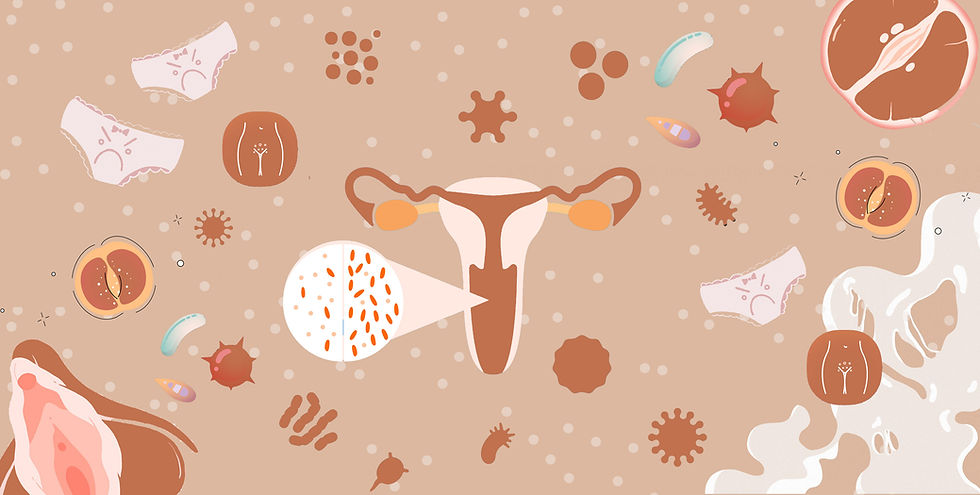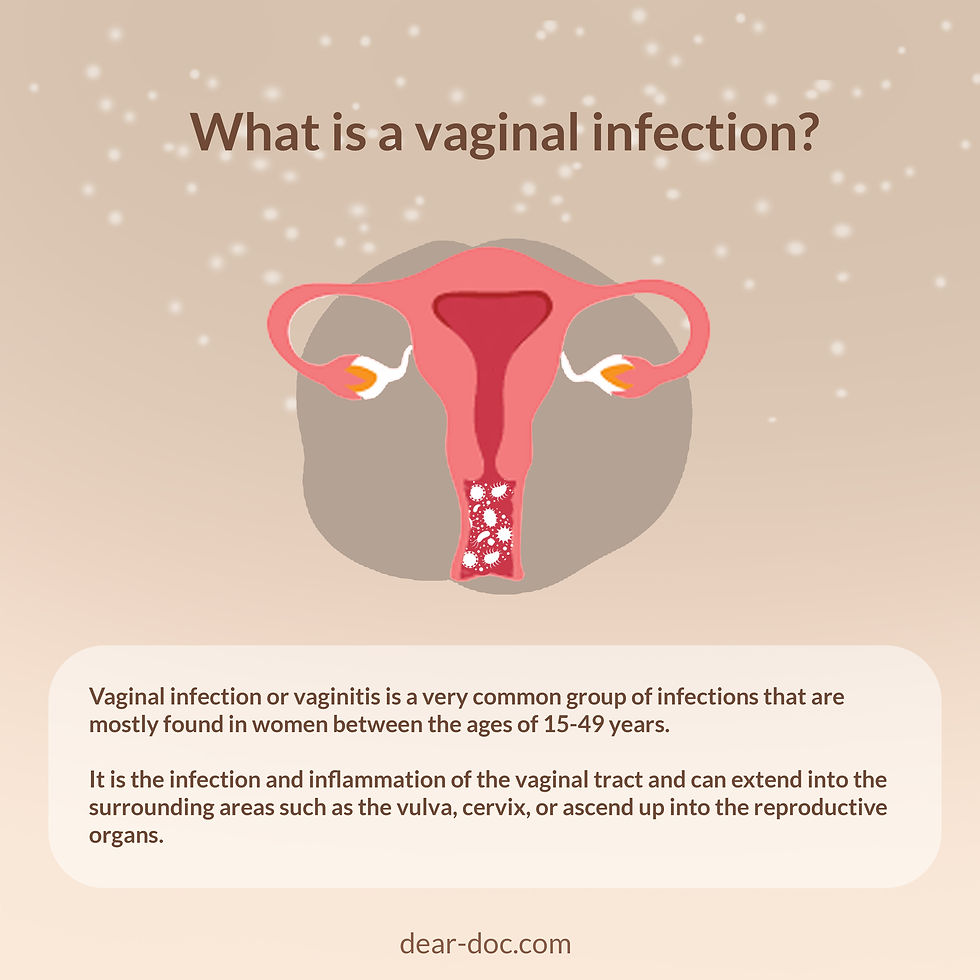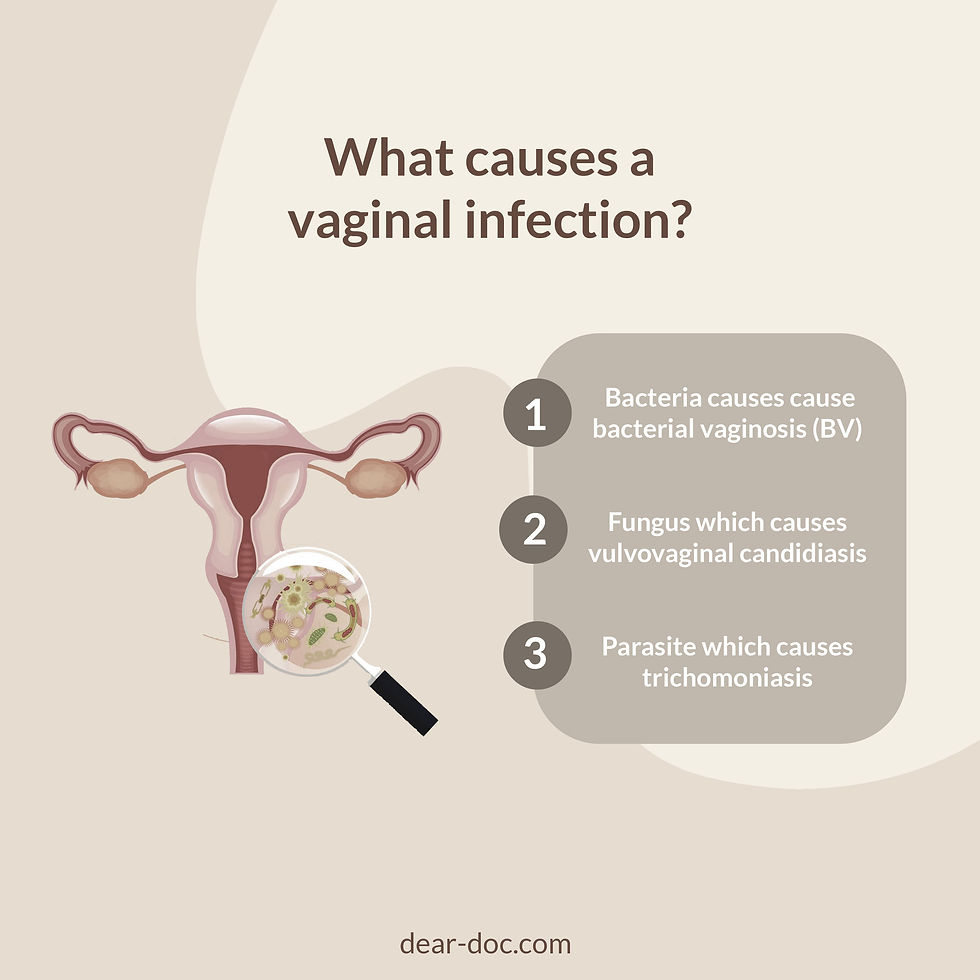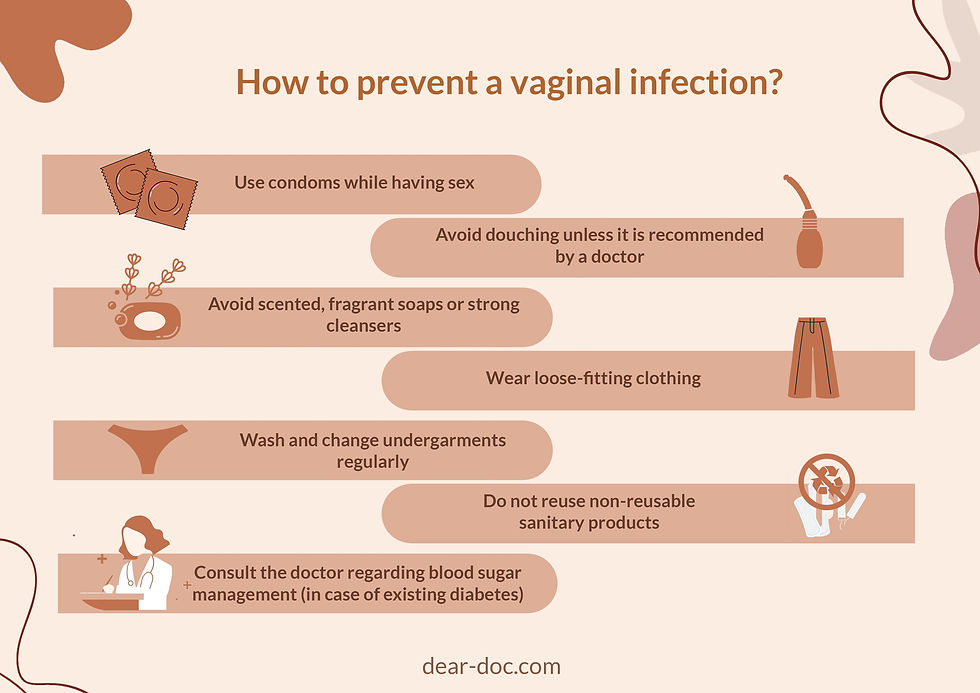Vaginal Infections 101
- Taniya Shekhawat
- Oct 23, 2023
- 4 min read
Updated: Oct 25, 2023

Vaginal infection or vaginitis, is a common group of infections that are mostly found in sexually active females, usually between the ages of 15-49 years.
As the term suggests, it is the infection and inflammation of the vaginal tract, but it doesn’t end there. Depending upon the organism causing the infection, it can extend into the surrounding areas such as the vulva, cervix, or ascend up into the reproductive organs.
This article will act as a primer for the most common causes of vaginal infections and also some of the uncommon causes, along with testing, treatment, and prevention of these infections.

What causes a vaginal infection?
Vaginal infections are mostly caused by 3 microbes: Gardnerella vaginalis (bacteria), Candida species (fungus), and Trichomonas vaginalis (parasite). These 3 are responsible for virtually all cases of vaginal infections and cause bacterial vaginosis (BV), vulvovaginal candidiasis, and trichomoniasis, respectively.
It’s important to point out that even though sexually active women are at a higher risk, these infections aren’t always sexually transmitted. The only exception to this is trichomoniasis, which is a sexually transmitted infection (STI).
Essentially, what happens is that due to weather conditions, sexual activity, and individual habits the vaginal flora and the normal vaginal pH is disturbed, causing an imbalance of the microbiome. The native “good” bacteria is displaced by another “bad” microbe that grows inside the vagina, leading to an infection. Tropical climate, like that in Singapore, can exacerbate the problem as excess moisture can allow and encourage the microbes to grow freely.
Other causes of vaginal infections
There are a few other bacteria that can seldomly infect the vagina. These are ureaplasma, mycoplasma, streptococcus, and staphylococcus. Although rare, they may produce symptoms similar to that of the 3 vaginal infections (bacterial vaginosis, candidiasis, and trichomoniasis).
Aside from infectious causes of vaginitis, there are also some non-infectious causes which are mostly due to an allergy towards a foreign object. Some of the common agents implicated in this are:
Frequent washing of the vagina (known as douching)
Seminal fluid (it increases vaginal pH, making it more alkaline)
Lubricants
Latex condoms (some are allergic to latex)
Scented soaps and cleansers
Tight, close-fitting clothing
All of these have the potential to irritate the vagina and cause vaginitis, which in turn can predispose to other infections and STIs.

How do I know if I have a vaginal infection?
Signs and symptoms can differ according to the cause of the infection, but there are some common features shared by all. For example:
Abnormal vaginal discharge - this refers to any discharge that is unusual or different from what one may or may not normally see. It is important to point out that there is no definition of normal vaginal discharge as it differs from woman to woman and even changes throughout the menstrual cycle
Strong odor down there - vaginal infections can often alter the environment in such a way that it produces an odd and foul-smelling odor
Itching, irritation, swelling, redness, or burning sensation in the vagina or vulva
Discomfort/burning sensation while peeing (known as dysuria)
Painful sexual intercourse (known as dyspareunia)
Vaginal spotting, that is, mild bleeding not related to menstruation
There are also some specific signs or symptoms that can help one suspect the particular type of vaginal infection. For example:
Odor - Trichomoniasis has a pungent odor, bacterial vaginosis has a fishy odor, and candidiasis usually doesn’t have any characteristic odor.
Color - Trichomoniasis has a green-yellow discharge, bacterial vaginosis produces a thin white to gray discharge, and candidiasis is thick and appears like cottage cheese.
There are other ways to differentiate these infections, but those are best done through lab tests.
Treatment of vaginal infections
It is best to consult a doctor if you notice any of the above signs or symptoms.
Treatment for vaginal infections is cause-specific. Upon correct diagnosis, the doctor will recommend treatment with suitable antimicrobial drugs for a certain duration. Although sexual partners aren’t usually infected, and treatment isn’t generally given, they may be treated if the cause was an STI, such as trichomoniasis.
Some of the commonly used antimicrobial medicines that are used are metronidazole, tinidazole, clindamycin, fluconazole, and miconazole. They are taken either as a tablet or in ointment form.
How to prevent a vaginal infection
To prevent vaginal infections, there are some things that one can easily do, such as:
Use a condom during sex
Avoid douching, unless it is recommended by a doctor
Avoid scented, fragrant soaps or strong cleansers
Wear loose-fitting clothing
Wash and change undergarments regularly
Do not reuse non-reusable sanitary products
In case of existing diabetes, consult the doctor regarding blood sugar management
Although there’s no clear evidence, eating yogurt frequently, or using probiotic supplements can help maintain a healthy bacterial environment.
If tested positive, try to refrain from sexual activities until treatment is over, as it might interfere or slow down treatment.

We hope that this information is helpful. Feel free to reach out to us if you would like to know more or suspect an infection.
Dear Doc offers consultation with a female doctor, who is an expert in female and sexual health. To know more, check out our services.
____________
References
Kasper, D. L., et al. Harrison's principles of internal medicine (20th edition.). New York: McGraw Hill Education., 2018. (pg. 981-983, 1619-1620)
Ralston, Stuart H. Davidson’s Principles and Practice of Medicine. 23rd ed. Elsevier Health Sciences, 2018. (pg. 335-336)




Comments